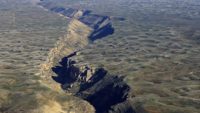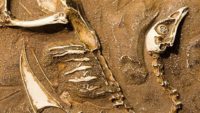Descriptions of feathered dinosaurs continue to wing their way into scientific literature. While most researchers see each new example as another link in a Darwinian story of reptiles somehow evolving into birds, others fit these fossils into more classical categories. Two new discoveries give owners of these opposing views new opportunities to peck at each other’s ideas of bird beginnings. Both cases are easy to land on a creation-friendly… More… …read more Source: icr.org
When did they form and how? …read more Source: creation.com
Within months, a river was so drastically changed that many could not believe what they were seeing. …read more Source: creation.com
Discovering fossil spiders has become fairly common.1 Each time they have been 100% spiders, not vague evolutionary ancestors with partial or transitional features.2 Now a whole collection of “ancient” spiders from the Cretaceous (Albian) Jinji Formation in Korea has been discovered.3 This is a significant discovery because these small arachnids were found to have a special eye mem… More… …read more Source: icr.org
If most coal was formed from plants other than lycopods, then do we need the floating forest hypothesis to explain the origin of coal? …read more Source: creation.com
The last time I checked, sharks didn’t swim on land. Most shark species inhabit saltwater oceans. Maybe tyrannosaurs swam some, but they didn’t dwell in oceans. Yet somehow sharks and tyrannosaurs died and were buried together. This curious combination calls for a big rethink on an issue that a new study just made bigger. More… …read more Source: icr.org
Can happen faster than secular scientists think. …read more Source: creation.com
By Troy Lacey Two amber fossil finds have revealed some interesting examples of similarities between fossil and extant forms, both in morphology and in lifestyle/behavior. …read more Source: AIG Daily
By Heather Brinson Bruce Do fossils require millions of years to form? Hardly! Even secular geologists now recognize that rocks form very quickly. …read more Source: AIG Daily
Secular science believes Earth’s oceans have existed for about four billion years.1 They also think the level of the ocean has remained about the same over that vast period of time. However, a new study published in Nature creates serious problems for the uniformitarian origin of our oceans and their long-term sustainability.2 Chen Cai and his colleagues from Washington University … More… …read more Source: icr.org
How did this fascinating tourist feature form? …read more Source: creation.com
By Ken Ham A recent editorial reminded me of the secular claim that diamonds take billions of years to form. Is that true? …read more Source: AIG Daily
Archaeopteryx is a big word that simply means “ancient wing.” It refers to a set of fossils of a strange-looking extinct bird. Books promoting evolution often show pictures of Archaeopteryx. Its beak had small teeth, so many scientists see it as playing a lead role in an unthinkably long plot about reptiles evolving into birds. Others admit it was just a bird. New research places Archaeopteryx more firmly in the bird category than ever before. Read More: Does Archaeopteryx Show Bird Evolution? | The Institute for Creation Research
A Polish research duo described the remains of an elephant-size synapsid from upper Triassic rocks. Only it’s not supposed to be there. Secular reactions express shock at this turn from a longstanding evolutionary tale. Synapsids are commonly referred to as “mammal-like reptiles,” but were neither reptiles nor mammals. They were unique—the sail-finned dimetrodon was a synapsid. Like dinosaurs, … More… …read more Source: icr.org
Large natural bridges and freestanding rock arches are structures left behind after erosive action, features called erosional remnants. Along with several other types of landforms examined in this magazine in recent years, they provide further evidence for rapid erosion in the late stages of Noah’s Flood. Read More: The puzzle of large natural bridges and freestanding arches – creation.com
Response to a correspondent who had taken a CMI writer to task, claiming that 14C, dendrochronology, and uranium-thorium (U-Th) dating techniques are trustworthy. …read more Source: <a href=http://creation.com/carbon-dating-fooling-who target=_blank title="Carbon dating-who is fooling who?” >creation.com
By Ken Ham The ice age, a time of wooly mammoths, saber-toothed cats, and glaciers, may seem like a great mystery. But it’s not a mystery when we start with the history found in God’s Word. Indeed, that history actually explains how an ice age is even possible—in a secular worldview it’s very difficult to explain one ice age, let alone the many that secularists believe in. Now, you may be wondering what the Bible says about the ice age. Well, the Bible doesn’t specifically tell us there was an ice age, but we can observe today that there was [More]
Salamander-like footprints preserved in sandstone have long fascinated Grand Canyon hikers and rafters. Insights from a new study of the track patterns intensify an old trackway mystery. But Noah’s Flood can help solve this mystery. It boils down to this: How could a four-footed track maker leave so many details of its foot if it was walking on windblown sand dunes? Footprints in dry sand leave shapeless divots … More… …read more Source: icr.org
Every student in US public schools will likely come across illustrations claiming the earth’s tectonic plates have been moving slowly for millions of years. …read more Source: AIG Daily
After speaking at a church recently, a young man approached me. I thought he might have a question. Instead, he handed me a 6-page essay he had written. It was a defence of a form of Day-Age creationism, the belief that the days of Genesis were actually long periods of time. Normally, I would not spend too much time on such a thing, but the young man impressed me as humble and studious. He also reminded me of myself at that age, when I was trying to defend that very same position. But when I read his paper, I saw [More]
The remarkable fossils found in the Cambrian rocks provide devastating evidence against Darwin’s theory. …read more Source: creation.com
What evidence do we see that a global Flood devastated the earth’s surface during Noah’s day—on a scale unlike anything we see today? …read more Source: AIG Daily
In 1994, Bolivian workers quarrying high-grade limestone for cement reached a layer with too much quartz, a hard mineral, so they left it alone.1 As quarrying continued, more and more of the unwanted layer was exposed, forming a huge cliff and revealing hundreds of dinosaur trackways. The tracks are of at least eight different kinds of dinosaurs, including a pair of titanosaurs and a herd of 16 ankylosaurs. The layer also contains the longest dinosaur trackway in the world, over 500 m (1,640 ft), by a small theropod,1 possibly a juvenile Tyrannosaurus rex.2 Read More: The Cal Orcko (‘Lime [More]
By Kurt P. Wise Fossil Grove offers multiple evidences in support of a huge forest biome floating atop the world’s pre-Flood oceans. …read more Source: AIG Daily
By Dr. Andrew A. Snelling Most people, including Christians, would still claim dogmatically that the earth looks old. But why does the earth supposedly look old? …read more Source: AIG Daily
Since the 1990s, cross-section images of mantle tomography have shown visible slabs of oceanic lithosphere (which includes oceanic crust) descending hundreds of miles beneath ocean trenches into subduction zones.1 These descending plates have been imaged all the way down to the top of the earth’s outer core2 and are composed of cold, brittle, dense rock about 62 miles thick. Researchers from the Univ… More… …read more Source: icr.org
Do ‘laterite’ soils take a million years to form? …read more Source: creation.com







































